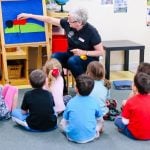Composite classes are created by combining 2 or more year levels into the one classroom, with instruction provided by the same teacher.
Opinions on the practice are divided amongst both educators and parents alike, so we have highlighted the most noteworthy points both for and against the composite classroom for those parents who would like to know more about their child’s educational environment, and how this may impact on their learning.
Potential disadvantages of a composite class
A composite classroom is most likely created for one of two reasons;
- the school abides to a philosophy of learning which requires students to be taught in a composite situation, or
- the year level numbers are low or uneven so the school has therefore decided to place students in composite rooms to improve budget outcomes.
State schools in Queensland tend to create composite classrooms for the latter reason. This is why some educators and parents worry that the students in composite classes are being placed at risk of a below par education. It has been argued that a composite class provides such a large gap between the lowest and highest achieving students that there is bound to be a demographical error, with some students benefiting and others missing out.
There is particular concern for those students at either end of the academic scale, namely those considered to be gifted or high-achievers, and those who are struggling with either learning difficulties or disabilities.
This issue is further compounded when considering the impact of the Australian Curriculum which requires teachers to adhere to very specific year level guidelines, potentially causing a very clear divide between each grade within the class, and adding an extra element of stress to the teacher’s already heavy workload.
This may mean less time spent on attending to the individual needs of each child, including that of your own. Can a teacher truly differentiate for such a wide spread of ages and abilities?
Benefits of a well-run composite class
Despite the bleak prognosis that this perspective depicts, there are also a variety of tangible benefits of composite classes.
Yes some schools have created composite classes due to budget requirements or low/uneven student numbers, an issue particularly relevant to small schools, but schools often choose to place their most experienced teachers in these roles.
Differentiation is the act of taking a concept being taught universally to all students within a class, and creating related tasks at varying levels of complexity. This is something which experienced teachers, and those who work in composite classrooms, can do exceptionally well.
When differentiating instruction in this way, teachers are providing for the needs of students at multiple levels of understanding at the same time which in turn allows students to see clearly not only where they are at, but where they are going.
Specifically, the Montessori Method caters to the individual needs of students through a differentiated system of learning that requires as part of the methods corresponding educational philosophy that students be grouped in what mainstream schools would consider to be composite classes spanning across 3 year levels. Students from early childhood to primary, and in some situations high school, learn with the same teacher for 3 year cycles between the ages of 3-6, 6-9, 9-12 and so on.
Grovely State School in Brisbane is one of an increasing number of state schools in Queensland which have welcomed the Montessori Method and its requirement of composite classrooms into their educational philosophy. This is an approach which has proven to be successful in aiding students to attain educational successes across the curriculum.
The composite classroom therefore has the potential to be rated highly alongside its single year counterparts.
Choosing for or against composite classes
Teachers who have chosen to work in composite classes attest to the great benefits of students learning in a multi-age room, suggesting that younger students look up to their older peers and aspire to learn out of admiration for their skills and knowledge, as opposed to the desire for extrinsic rewards such as stickers or prizes. Older students enjoy the sense of guidance that they can provide to their younger counterparts alongside being a positive role model.
Mirroring society, the composite classroom has the potential to focus less on age differences or the restrictions set by specific year level curricular outcomes and more on the stage of learning so as to meet each child’s individual needs.
Whether you have the choice of placing your child in a composite class, or it is a necessary step for your child within the context of their school, it is important to note that regardless of the classrooms set-up the quality of your child’s education will come down to:
- the support provided by the school to both staff and students,
- the capability of your child’s teacher, and
- the support which you provide them.
This is so they may realise their fullest potential both academically, socially and beyond.





